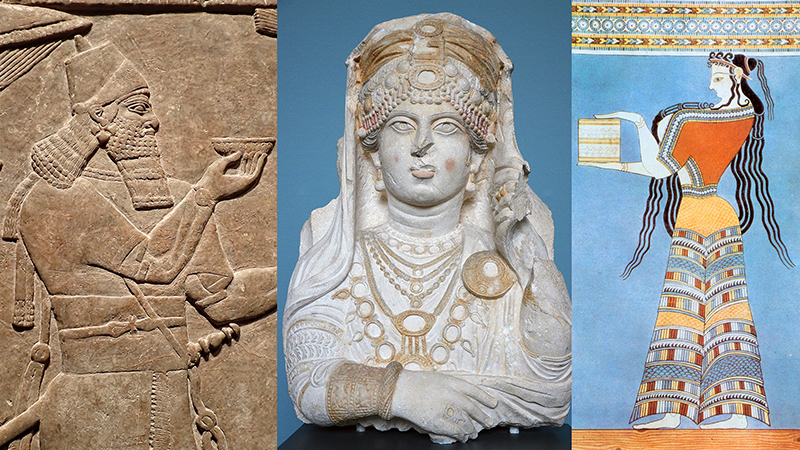About the lecture
The Neo-Assyrian queen stood above all other mortal women. She was a paragon of ideal beauty and imperial power, as expressed through her lavish adornment, personal throneroom, monuments, and seals. Dressed to impress, queens engaged in the political, military, economic, and religious affairs of the state. In so doing, they not only emulated the appearance (beauty) of the goddesses they venerated, but they also modeled divine characteristics and agency (power). Without question, goddesses were exemplars for the beauty and power of Neo-Assyrian queens.
This presentation will begin by describing the adornment excavated from the queens’ tombs at Nimrud and demonstrate how it may be reconstructed into imperial regalia. That regalia mirrored aspects of divine dress portrayed in texts, such as the Descent of Ishtar and the Love Lyrics of Nabu and Tashmetu, and illustrated in art. In addition, poetic descriptions of sex appeal as well as images of nude goddesses and fantastical female figures may have reflected aspects of bodily perfection onto the queens with whom they were associated. Beyond visual similarities, we will also investigate with which goddesses (and which divine attributes) queens were most closely associated in the written and visual records. Through this analysis, we may ascertain some of the most significant attributes of queenship. Finally, we will consider how queenship, as an institution, was inspired by the activities, relationships, and domains of various goddesses. We will then return to the topic of queenly beauty, considering it not only in its external expression as attractiveness, but also as an embodiment of divinely-inspired ideals that empowered queens as personifications of empire.
About Dr. Gansell

Dr. Amy Gansell is an Associate Professor of Art History in the Art and Design Department at St. John’s University (New York City). She holds a doctorate in ancient Near Eastern Art History from Harvard University. Much of her research has focused on ancient Levantine ivory sculpture, Mesopotamian jewelry, and Assyrian queens. She has held prestigious grants from the Mellon Foundation, the US National Endowment for the Humanities, and the American Academic Research Institute in Iraq, and her work has been published in international scientific journals, including the Cambridge Archaeological Journal and the American Journal of Archaeology. Gansell is co-editor of two volumes: Testing the Canon of Ancient Near Eastern Art and Archaeology (Oxford University Press, 2020) and CyberResearch on the Ancient Near East and Neighboring Regions (Brill, 2018). She is currently writing a book on the beauty and power of ancient Assyrian queens.
Suggestions for further Reading
- Amy Gansell, “Images and Conceptions of Ideal Feminine Beauty in Neo-Assyrian Royal Contexts, c. 883-627 BCE,” pp. 391-420, in Critical Approaches to Ancient Near Eastern Art, ed. Marian Feldman and Brian Brown, Boston: Walter de Gruyter, 2013.
- Amy Gansell, “The Iconography of Ideal Feminine Beauty Represented in the Hebrew Bible and Iron Age Levantine Ivory Sculpture,” pp. 46-70, in Image – Text – Exegesis: Iconographic Interpretation and the Hebrew Bible, ed. J. M. LeMon, et al., New York: Continuum/T&T Clark, 2014.
- Amy Gansell, “Dressing the Neo-Assyrian Queen in Identity and Ideology: Elements and Ensembles from the Royal Tombs at Nimrud,” American Journal of Archaeology 122 (2018): 65-100.
- Tallay Ornan, “The Queen in Public: Royal Women in Neo-Assyrian Art,” pp. 461–477, in Sex and Gender in the Ancient Near East: Proceedings of the 47th Rencontre Assyriologique Internationale, Helsinki, July 2–6, 2001, Part II, edited by Simo Parpola and Robert M. Whiting, Helsinki: Neo-Assyrian Text Corpus Project, 2002.
- Saana Svärd, Women and Power in Neo-Assyrian Palaces, SAAS 23, Helsinki: The Neo-Assyrian Text Corpus Project, 2015.
A Digital Lecture Series on Beauty, Attractiveness and Sex Appeal in the Ancient Mediterranean World
The purpose of this lecture series is to investigate concepts of beauty and attractiveness in ancient cultures, and to explore how these concepts relate to gender, hierarchy and power.
Five excellent international researchers, experts on the material cultures and texts of the ancient Mediterranean, will each present a 30-minute lecture, followed by amble time for questions and discussion.
We are interested in mapping ancient attractiveness as broadly as possible and therefore we encourage our speakers to consider beauty from a multi-sensorial perspective and to give thought to both touch, smell, taste, hearing and vision in constructions of beauty and sex appeal.
The lecture series is organized by Professor Anne Katrine de Hemmer Gudme and hosted by The Faculty of Theology at the University of Oslo and the Faculty’s research group Biblical Texts, Cultures and Receptions.
Digital event - how to participate
The seminar will be held digitally due to Covid-19. If you wish to attend the the conference you need to register in advance.
Registration.
- A zoom link will be sent to you before the event.
- You can download Zoom or use your browser: https://zoom.us/download
- This lecture is part of the lecture series Ancient Attraction
